|
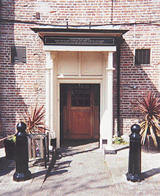
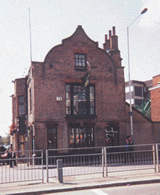
|
Cromwellian Britain - Uxbridge,
Middlesex
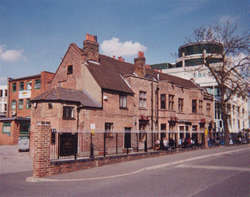 The town of Uxbridge is located in the London Borough of Hillingdon
close to the River Colne, on the border with Buckinghamshire in the
north-west part of Middlesex. It is easily reachable by road via the A40
or by the underground Metropolitan and Piccadilly lines, which both
terminate at Uxbridge station in the centre of the town. The town of Uxbridge is located in the London Borough of Hillingdon
close to the River Colne, on the border with Buckinghamshire in the
north-west part of Middlesex. It is easily reachable by road via the A40
or by the underground Metropolitan and Piccadilly lines, which both
terminate at Uxbridge station in the centre of the town.
The county of Middlesex has natural borders on three sides made up of
the rivers Lea, Colne and Thames, and is surrounded by the large
counties of Essex, Hertfordshire, Buckinghamshire and Surrey. It is the
second smallest county and in 1965 due to the London Borough Act it
ceased to exist as a county administrative area. The county has always
been important due to its proximity to London and in the fifteenth,
sixteenth and seventeenth centuries royalty (especially Henry VIII and
Elizabeth I) and nobility had residences here which meant that they were
within easy reach of both court and parliament without having to cross
the River Thames.
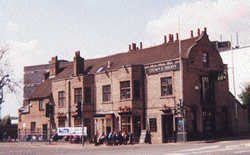 The Domesday Book of 1086 gives us a clear record of the area with a
list of landowners and a concise inventory of terrain, buildings and
livestock. Prior to this period, records are sketchy; the only real
traces of Roman occupation are the three important roads which dissect
the county – Ermine Street, Watling Street (Edgeware Road) and Thames
Street (Bath Road). We know the area was populated by Middle Saxons, the
origin of the name ‘Middlesex’. The placenames are Saxon and through
archaeology there are traces of a dyke in Harrow and moats and camps
elsewhere. Some members of the Lincolnshire tribe called ‘Wixan’ set up
home in the area controlling the vital crossing point at the River Colne,
the origin of Uxbridge; this was politically important to the Saxons who
shared a border with the Mercians. The Domesday Book of 1086 gives us a clear record of the area with a
list of landowners and a concise inventory of terrain, buildings and
livestock. Prior to this period, records are sketchy; the only real
traces of Roman occupation are the three important roads which dissect
the county – Ermine Street, Watling Street (Edgeware Road) and Thames
Street (Bath Road). We know the area was populated by Middle Saxons, the
origin of the name ‘Middlesex’. The placenames are Saxon and through
archaeology there are traces of a dyke in Harrow and moats and camps
elsewhere. Some members of the Lincolnshire tribe called ‘Wixan’ set up
home in the area controlling the vital crossing point at the River Colne,
the origin of Uxbridge; this was politically important to the Saxons who
shared a border with the Mercians.
In the years which followed the Norman Conquest, Uxbridge continued to
grow in size and importance. In 1179 it was granted its first market
charter, in 1281 an annual fair on St Margaret’s Day (20 July) and
thirteen years later a second fair (Michaelmas) and market charter
(Mondays). Uxbridge began to prosper with increases in population; the
surrounding areas sent their produce to Uxbridge. It soon became the
service centre for the milling of corn – two and a half mills were
documented in the Domesday Book and by the nineteenth century thirteen
mills were in operation at its height.
In the sixteenth century Uxbridge was recognised as the first stopping
point on a traveller’s route to and from London. Many inns were built at
about this time to cater for the increase in the transitory population.
During the seventeenth century Uxbridge’s fortunes fluctuated largely
due to its dependence on the corn market and inns, both of which
suffered when there were poor harvests or when plague struck, as it did
in 1625, 1636 and 1665, travellers avoiding the town.
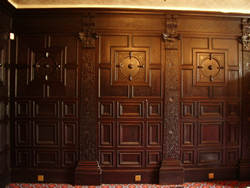 The Lordship of the Manor was held by the Countess of Derby who was the
patron of both Spenser, author of The Faerie Queene, and John Milton,
who became Secretary for Foreign Tongues under the republican govemment.
She had the legal right to collect tolls from the town of Uxbridge,
which she did up until the start of the civil war. During 1630 there
were signs that the population were not happy with this situation,
believing they should be beneficiaries of the market tolls. It was after
attacks on her toll collectors by armed mobs that the Countess sought
legal action and the ultimate threat of the Star Chamber, which
frightened the inhabitants into submission. In October 1633 they joined
the Countess at a banquet. In the foyer of the Civic Centre the events
are illustrated in a mural. The Lordship of the Manor was held by the Countess of Derby who was the
patron of both Spenser, author of The Faerie Queene, and John Milton,
who became Secretary for Foreign Tongues under the republican govemment.
She had the legal right to collect tolls from the town of Uxbridge,
which she did up until the start of the civil war. During 1630 there
were signs that the population were not happy with this situation,
believing they should be beneficiaries of the market tolls. It was after
attacks on her toll collectors by armed mobs that the Countess sought
legal action and the ultimate threat of the Star Chamber, which
frightened the inhabitants into submission. In October 1633 they joined
the Countess at a banquet. In the foyer of the Civic Centre the events
are illustrated in a mural.
During the civil war and Commonwealth the population took the
opportunity to collect the tolls as the then Lord of the Manor, Lord
Chandos, the Countess’s grandson, was a royalist and had fled abroad.
After the Restoration his successor resumed collecting tolls until 1695,
when the right was purchased by a group of residents led by a grandson
of the Countess’s protagonist.
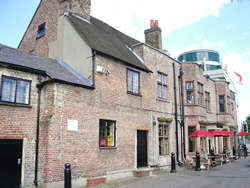 At the end of the High Street on the Oxford Road stands the inn called
The Crown and Treaty House. It faces the entrance to the Highbridge
Industrial Estate and is opposite two very modern buildings of the
1990s. Above the entrance a legend is written, ‘Ancient Treaty House
where the ill-fated Charles I held the memorable, but unsuccessful
treaty with his Parliament in January 1645’. At the end of the High Street on the Oxford Road stands the inn called
The Crown and Treaty House. It faces the entrance to the Highbridge
Industrial Estate and is opposite two very modern buildings of the
1990s. Above the entrance a legend is written, ‘Ancient Treaty House
where the ill-fated Charles I held the memorable, but unsuccessful
treaty with his Parliament in January 1645’.
The building was then two thirds larger and was originally known as
Place House when it was built in the early sixteenth century. During the
eighteenth century, with the expansion of the coaching trade through
Uxbridge, part of the house was demolished and the Oxford Road was built
through the gardens. The house then became a coaching inn with stabling
for forty horses. The interior panelling which can be seen in the inn
today is original. In 1924 it was removed and sold to an American
businessman who used it to furnish his office in the Empire State
Building (in the 1920s and 1930s there was a renewed interest in wood
panelling and several designers were using it in their buildings). In
1953 the wood panelling was returned as a coronation gift to Elizabeth
II who had it reinstalled in the inn.
Uxbridge was a parliamentary stronghold and an obvious venue for the
peace negotiations as it was on the Oxford Road and suitable for the
royalist representatives from Oxford and the parliamentary commissioners
from London. Each side was represented by thirty-two men, accommodated
on both sides of the High Street. The George Inn was the headquarters
for the parliamentary commissioners and they also took over all the
buildings on the north side. The south side, except for one house, was
reserved for the royalist commissioners with their headquarters at The
Crown Inn.
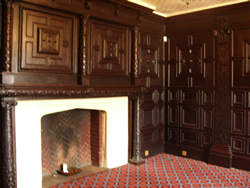 The negotiations were doomed to failure from the outset due to the
attitude of Charles I and his view that he was above and beyond earthly
laws. He believed he was put there by God and therefore subjects must
obey their king without question. Sir Edward Nicholas, who was Secretary
of State and one of the royalist commissioners, was urged by the king at
every opportunity to remind the parliamentary commissioners that they
were ‘arrant rebelles and that their end must be damnation, ruine, and
infamy, except they repented...’. On 4 March a delegation was sent to
the City of London to report on the failure of the negotiations and to
secure an advance of £80,000 for the New Model ordinance. Speaker
Lenthall said that ‘this army, under God, is the principal means to
preserve us in safety’, and the diarist D’Ewes wrote ‘no way to safety
now but the sword’. The negotiations were doomed to failure from the outset due to the
attitude of Charles I and his view that he was above and beyond earthly
laws. He believed he was put there by God and therefore subjects must
obey their king without question. Sir Edward Nicholas, who was Secretary
of State and one of the royalist commissioners, was urged by the king at
every opportunity to remind the parliamentary commissioners that they
were ‘arrant rebelles and that their end must be damnation, ruine, and
infamy, except they repented...’. On 4 March a delegation was sent to
the City of London to report on the failure of the negotiations and to
secure an advance of £80,000 for the New Model ordinance. Speaker
Lenthall said that ‘this army, under God, is the principal means to
preserve us in safety’, and the diarist D’Ewes wrote ‘no way to safety
now but the sword’.
In June and July 1647 the New Model Army made their way to Uxbridge and
set up their headquarters (a garrison was maintained here until 1651).
Fairfax appointed Cromwell and nine others to discuss with parliamentary
commissioners at the Katherine Wheele Inn ‘The Humble Remonstrance’ (The
Humble Representation of the General Council of the New Model Army), a
document proclaiming the army as the fourth estate of the realm with
proposals for its own maintenance. Cromwell stayed at The Crown Inn,
which had been the royalist headquarters during the peace negotiations
of 1645. The House of Commons chose to ignore the army’s demands and
therefore failed to prevent the army’s subsequent occupation of London.
During the reign of Edward VI Uxbridge had become Protestant and managed
to remain so despite pressure from Roman Catholic Mary, who had three
Protestants burnt at the stake as an example to the residents. Several
puritan ministers fled here after the Restoration, among them Oliver
Cromwell’s chaplain Hezekiah Woodward, who had been Vicar of Bray. Until
his death in 1675 he was the leader of the Independents who secretly
worshipped in private houses. They later became known as
Congregationalists and their meeting house was built in 1716. The
Friends Meeting House on the corner of Belmont Road and York Road dates
from 1817 and replaced the original 1692 Meeting House on this site. The
town has been the home of Quakers since 1658. During the eighteenth
century Uxbridge was again in the forefront of a nonconformist revival
when wealthy Quaker families arrived, among them the Hulls, who were
related to Elizabeth Fry. John Wesley came and preached in Uxbridge and
it was during this period that some of the religious buildings were
replaced.
The sixteenth century Queen’s Head and The King’s Arms coaching inns can
still be seen, and a number of other old buildings survive in the town.
In the main, however, Uxbridge had changed a great deal since
Cromwellian times.
By Jane Mills
|
